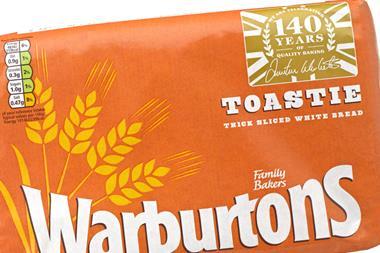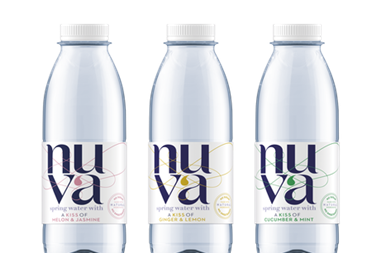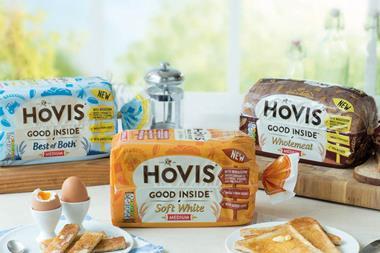Click here for the full rankings.
Grocery brands are falling back to earth with a bump. With deflation gripping the economy, competition for supermarket shelf space never fiercer and the discounters doing a roaring trade with their ‘like brands but cheaper’ promise, 56 of Britain’s 100 Biggest Grocery Brands have suffered a fall in value in the past year. and 61 have seen prices fall.
And it’s across the board. Just three of grocery’s 10 biggest names - Dairy Milk (4), Nescafé (7) and Pepsi (9) - have managed to grow value in the past year. The combined loss of the top 10 brands stands at an eyewatering £105.6m, accounting for more than a quarter of the top 100’s combined loss of £408.5m, a 2% decline. The plummeting sales are not all down to price deflation, either; Britain’s biggest brands have shifted 87.8 million (0.6%) fewer units.
Yet some are still gaining altitude at an impressive rate. Alpro (59) has turned in the greatest growth, worth £27.6m. Pepsi (9) has defied slumping sales of carbonated soft drinks with growth worth £22.6m. Kinder (83) is soaring, its £22.4m growth taking it into the top 100 for the first time. How are they doing it? And who’s down and out?
Who’s in?
- 83 (109) Kinder: A keen eye on portion control and sharing formats and savvy NPD have delivered an extra £22.4m
- 94 (101) Plenty: Big ad spend has helped Plenty clean up in a category defined by falling prices and own label growth. Up £6.8m
- 95 (11) Twirl: Sharing is caring for Twirl. The brand’s £12.4m growth, driven primarily by sharing format Twirl Bites, has catapulted it into the top 100
- 96 (110) Lindt Lindor: Up a cool £11m and into the top 100, thanks partly to the launch of its first foray into sharing slabs with the Hello collection
- 99 (107) Highland Spring: The posh bottled water brand has sprung into the top 100 with growth of £5.1m. A £1.6m TV campaign helped
One thing’s for certain: it’s considerably harder for brands to get off the ground than it was a year ago. In our 2015 report, 42 of the top 100 brands were suffering from deflating average unit prices. As competition between the supermarkets has escalated, the promise of cheaper brands is being used to lure shoppers through the doors.
“Clearly there’s more promotional pressure and retailers are also taking a view on the everyday price of one brand versus another,” says Leendert den Hollander, general manager at Coca-Cola Enterprises, which has seen the average price of three of its five top 100 brands - Fanta (62); Monster Energy (73); Capri-Sun (97) - fall in the past year. “In partnership with our customers, we need to try to define how we can bring value. To a large extent the onus is on us. We have to ask: how do we bring new news; how do we get consumers ready to pay the right price?”
Responding to consumer trends with relevant NPD is crucial. The £16m growth of Monster Energy, which has risen seven spots up this year’s ranking, is a case in point; in September, CCE unleased zero-sugar sub-brand Monster Energy Ultra, a range that has been a key driver of the brand’s overall growth. The launch of no-added-sugar Capri-Sun, in anticipation of Tesco’s July axing of added-sugar kids’ drinks, and the January extension of Coke Zero Cherry into 330ml cans are other examples of how brands are changing with the times.
Note the absence of sugar. With Britain going to war with the white stuff and health a growing concern for Brits at the checkouts, brands that have developed ‘healthier’ lines or marketed themselves on their nutritional benefits are defying the downturn.
Examples abound. Alpro is flying high off the back of booming demand for dairy-free products and its extension into new categories, such as potted desserts. Innocent (26) is offsetting slumping sales of fruit juices with new functional smoothies, veg juice and coconut water.
Developing ‘healthier’ products is one thing; ensuring consumers understand what it is that differentiates them from the standard offering is another. For example, Coke (1) has conceded that it needs to do more to communicate what its different variants stand for, saying that only around half of consumers understand that Coke Zero contains no sugar, and new variant Coke Life contains 45% less sugar than standard Coke.
It could take a leaf out of Pepsi Max’s book. The ‘no sugar maximum taste’ cola has been the driving force behind Pepsi for years, and once again accounts for the lion’s share of the brand’s gains, thanks in no small part to marketing aimed with pinpoint precision at Pepsi Max’s target audience of young adults and teenagers.
“Ultimately, carbonates is suffering from a decline in relevancy amongst today’s consumers due to growing health concerns and a shopper base that is purchasing on autopilot,” says Phil Sanders, commercial director at Pepsi’s bottler & distributor Britvic.
Who’s out?
- 102 (96) Dr Pepper: A casualty of the war on sugar and the resulting backlash against fizzy pop, the doc has lost a whopping £4.1m
- 105 (99) Snickers: Investment in ads starring Rowan Atkinson and NPD hasn’t been enough to stop Snickers from bowing out. Sales are down £602,000
- 108 (97) Rowntree’s: Nestlé’s flagship confectionery brand has lost £7.2m as retailers have cut space for sweets and rivals have invested in sharing formats
- 111 (94) Wiseman: The milk brand’s days as a top 100 brand had been numbered for some time. Continuing price cuts in dairy have sealed its fate; down £12.3m
- 137 (92) Tate & Lyle: Sales have been anything but sweet for the sugar brand as retailers have hammered down prices and the market was flooded with cheap EU beet. Down £37.8m, or 39.4%. Ouch
Digital activity including YouTube videos of extreme sports, the brand’s UEFA sponsorship and cross-brand promotions with fellow PepsiCo-owned snack brands Walkers (3) and Doritos (35) have also helped, as has a social media and nationwide sampling campaign for Pepsi Max Cherry, which has delivered nearly £20m growth for the flavour variant.
Health concerns are redefining the snacking market also. Walkers, for example, has lost £37.7m (5.9%) of its value in the past year as shoppers have begun to turn away from fried potato crisps in favour of baked savoury snacks, such as United Biscuits’ Jacob’s (34), which has climbed four places up the ranking thanks to a flurry of launches, such as July’s Cracker Crisps, designed to lure shoppers away from potato crisps. No wonder Walkers and Walkers Sensations (101) have unveiled baked snack ranges in the past year.
The two biggest casualties of the year also reflect changing consumer habits (albeit retailers also played a part with delistings). Hovis (15) has lost £62.1m, Kingsmill (12) £58.4m, as consumers continue to ditch bread, partly as a result of negative health associations with white sliced. In response, Hovis has pledged to invest in developing its range of ‘healthier’ loaves, such as the protein-rich Sunflower & Pumpkin Seed product it launched in February. Meanwhile, fewer Brits are eating breakfast at home; fewer are packing lunches.
This is where innovation can play a crucial role. In recent years, Weetabix (44) has diversified with drinks and biscuits. Value has still fallen £1.3m - but its performance is much stronger than Special K (93), which is now in serious danger of falling out of the top 100 after nearly a quarter of its value (£28.1m) was wiped out.
Similarly, Warburtons (2) has weathered the storm with a combination of savvy innovation and big budget marketing. “NPD is a key area of investment - demonstrated by the launch of several new products over the last 12 months including Thin Bagels and most recently Giant Crumpets,” says Warburtons’ marketing director Mark Simester. The ad featuring the Muppets helped drive growth for the innovation. “‘The Giant Crumpet Show’ was also declared the most successful Christmas ad of 2015, according to consumer research carried out by independent researchers.”
Ensuring products are in the right format is also crucial. Pringles (31) has benefited from growing demand for snacks in sharing formats, a trend that’s also benefitted brands such as Kinder (83) and M&M’s (105).
John West (41) is another case in point. The brand has offset intense price competition in canned tuna through the development of new formats and products, such as its Spreadables range of sandwich fillers, and Infusions and Steam Pots ranges of added value tuna. The brand is up £6.1m in a floundering canned food market.
That a brand in one of the most commoditised markets in grocery can achieve such solid growth, makes it clear: brands can still fly high, so long as low prices isn’t their only USP.


















No comments yet